- Home
- Lake Powell, Utah
- Broughton Islands
- Barkley Sound, Vancouver Island
- Blog: Barkley Sound, Vancouver Island
- Desolation Sound
- Blog: Desolation Sound, British Columbia
- Princess Louisa & Gulf Islands, British Columbia
- Blog: Princess Louisa & Gulf Islands, British Columbia
- Great Loop Part 1, Chicago to Mobile Bay
- Blog: The Great Loop, Part 1, 1600 miles of River Boating. Updated 11-6-10
- Getting Boarded & Inspected
- Boating With Boots, the cat
- Checklist & Instructions
- Living in the World of 12 Volts
- Making Use of Smaller Spaces
- Ah, the Head & Shower
- Trailering and Camping with the Tug
- Tools & Cleaning Materials
- Trailering & Insurance: When bad things happen
- The Last Chapter
- About Us
- Contact Us
Storing Tools and Raw Materials
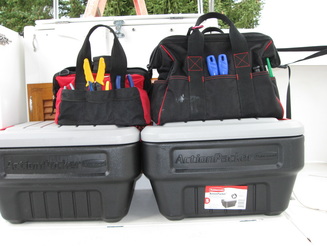
Boating means that your accept, on some level, the notion of being self-sufficient and that means being prepared for the common break downs and typical problems that will come to every boater, no matter how new the boat is, if you boat long enough, these will eventually happen to you.
We have learned through breakdowns, helping others, and reading boating articles what we like to bring with us. This is what works for us; you are on the wonderful path of self-discovery of what works for you.
All the tools and nearly all the supplies for repairs are contained in the bins and tool bags in this photo and all of them neatly store in the cave under the dinette, after the cushion is removed. Engine oil, coolant and distilled water, for the batteries, are the exceptions and these are kept under the port side cockpit step.
We have learned through breakdowns, helping others, and reading boating articles what we like to bring with us. This is what works for us; you are on the wonderful path of self-discovery of what works for you.
All the tools and nearly all the supplies for repairs are contained in the bins and tool bags in this photo and all of them neatly store in the cave under the dinette, after the cushion is removed. Engine oil, coolant and distilled water, for the batteries, are the exceptions and these are kept under the port side cockpit step.
The Main Tool Bag
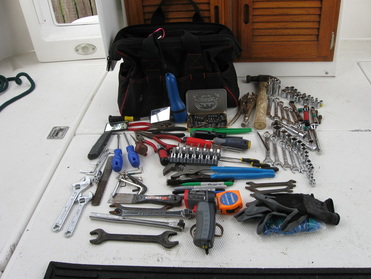
I like soft-sided tool bags over tool boxes or hard side cases because they are easier to move around and store on the boat. This is the main tool bag and contains the collection of the normal sockets and wrenches, both standard and metric, different bits for the variety of screw heads, screw drivers, etc.
Here are a couple of highlights that have worked well for me. An infra-red pyrometer (at the bottom of the photograph) that measures temperature because excessive heat is often the indicator of impending problems. A 5/16" socket and small ratchet wrench for tightening hose clamps in tight places; all of these will eventually need tightening. Off-set screw drivers. A mirror on a telescoping rod to see and a magnet on a telescoping rod to retrieve the screw or the tool that is beyond your reach. For removing an impeller, a medium sized needle nose pliers that are angled has been especially effective.
Here are a couple of highlights that have worked well for me. An infra-red pyrometer (at the bottom of the photograph) that measures temperature because excessive heat is often the indicator of impending problems. A 5/16" socket and small ratchet wrench for tightening hose clamps in tight places; all of these will eventually need tightening. Off-set screw drivers. A mirror on a telescoping rod to see and a magnet on a telescoping rod to retrieve the screw or the tool that is beyond your reach. For removing an impeller, a medium sized needle nose pliers that are angled has been especially effective.
The Electrical Bag
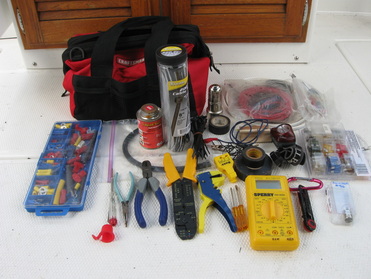
Over half the problems that I have dealt with are electrical; fuses, lights, and electronics. Vibration and corrosion takes a toll on the connections and usually when you need them the most. This bag as the fuses, extra wire, connectors and the means to use them.
The highlights in this bag are the headlamp and the multi-meter. Learn how to use the meter, including practicing with it, when you do not need it.
The highlights in this bag are the headlamp and the multi-meter. Learn how to use the meter, including practicing with it, when you do not need it.
The Minor Repair & Maintenance Box
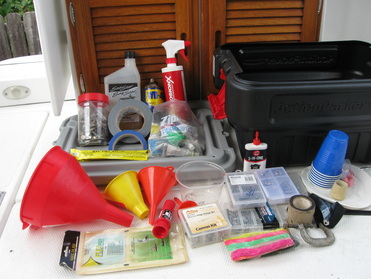
In this box are raw supplies for minor issues like a collection screws, nuts, washers, snaps for the canvas, a collection of different adhesives and the supplies to mix together two-part epoxy. A variety of funnels are needed for different purposes and each is labelled with the purpose (oil, coolant, diesel, battery, steering). At the top of the photo is a spray bottle of Corrosion X, WD-40 and steering helm fluid. At the bottom of the photo are quick fix supplies: putty, epoxy sheets and hose tape.
The Bigger Repair and Maintenance Box
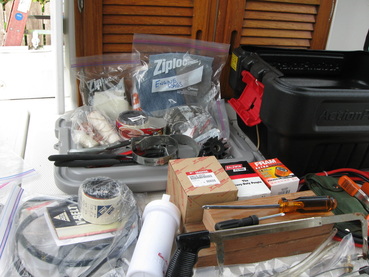
Mostly organized by using ziplock bags, there are belts, rags, sewing canvas, impellers, filters and the tools to use them, and a dinghy repair kit. Some larger tools are here: big screw drivers, hack saw, battery jumper cables, folding shovel and blocks of wood that serve as a temporary work bench. Plus, the miscellaneous collection of just "useful stuff" like thick wire, tubing, and cording.
Cleaning Supplies
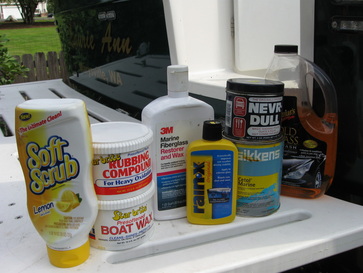
We do not use many products; what is shown is generally all that is used. Soft scrub really cleans the Starboard which is what our swim step and cockpit table are made off. For the hull and cabin, 3M Marine Fiberglass Restorer and Wax is the first line of attack. The Starbrite products of rubbing compound and boat wax really takes out the scratches, the oxidation and makes it all factory-new looking. When the hull is dulled with a mineral-like stain, using a solution of vinegar & water and then scrubbing with Dawn soap takes it all off without the need for rubbing compound.
Never Dull is used on the stainless rails. Rain-X is the cat's meow for the windows. Sikkens brand of teak finish is wonderful on the cockpit teak doors. Sand them, put his on and three years later they are still great. The boat is washed with a quality car wash soap that does not strip off the wax. A kitchen detergent soap, like Dawn, will cut that wax right off, which is fine if you want to re-apply wax.
Underway, the exterior of the windows are cleaned with fresh water and a rubber squeegee and then Rain-X'ed.
What is not shown is the vinegar and water solution in a spray bottle that is used to clean the interior surfaces and the Min Wax, Poly Wipe, Satin finish that is used on all the interior wood surfaces.
Never Dull is used on the stainless rails. Rain-X is the cat's meow for the windows. Sikkens brand of teak finish is wonderful on the cockpit teak doors. Sand them, put his on and three years later they are still great. The boat is washed with a quality car wash soap that does not strip off the wax. A kitchen detergent soap, like Dawn, will cut that wax right off, which is fine if you want to re-apply wax.
Underway, the exterior of the windows are cleaned with fresh water and a rubber squeegee and then Rain-X'ed.
What is not shown is the vinegar and water solution in a spray bottle that is used to clean the interior surfaces and the Min Wax, Poly Wipe, Satin finish that is used on all the interior wood surfaces.
